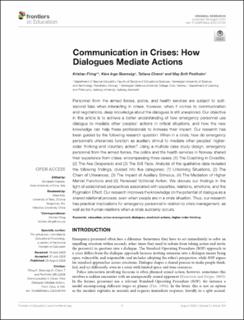| dc.description.abstract | Personnel from the armed forces, police, and health services are subject to split-second bias when interacting in crises, however, when it comes to communication and negotiations, deep knowledge about the dialogues is still unexplored. Our objective in this article is to achieve a better understanding of how emergency personnel use dialogue to mediate other peoples’ actions in critical situations, and how the new knowledge can help these professionals to increase their impact. Our research has been guided by the following research question: When in a crisis, how do emergency personnel’s utterances function as auxiliary stimuli to mediate other peoples’ higher-order thinking and voluntary action? Using a multiple case study design, emergency personnel from the armed forces, the police and the health services in Norway shared their experience from crises, encompassing three cases: (1) The Coaching in Crossfire, (2) The Axe Desperado and (3) The Still Face. Analysis of the qualitative data revealed the following findings, divided into five categories: (1) Unlocking Situations, (2) The Chain of Utterances, (3) The Impact of Auxiliary Stimulus, (4) The Mediation of Higher Mental Functions and (5) Renewed Volitional Action. We discuss our findings in the light of established perspectives associated with expertise, relations, emotions, and the Pygmalion Effect. Our research improves the knowledge on the potential of dialogue as a shared relational process, even when people are in a crisis situation. Thus, our research has practical implications for emergency personnel in relation to crisis management, as well as for human relations when a crisis suddenly occurs. | en_US |

